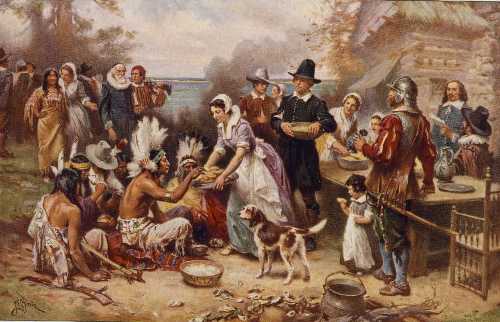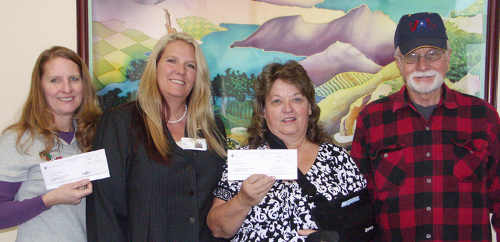
The first Thanksgiving by artist Jean Leon Gerome Ferris. Courtesy of Library of Congress.
Hello, readers! This Thursday is Thanksgiving, and in honor of the holiday, I thought it would be fun to look back on a column I wrote last year at this time about the evolution of the Thanksgiving meal. I enjoyed digging up these facts and learned a lot when I researched it.
Several months after I wrote it, I discovered quite by chance that the column was picked up by a newspaper in Plymouth, Massachusetts, which means what you’re about to read has also been read by those who live near the site of the first Thanksgiving meal.
I’ve kept the recipe I offered last year, a colonial recipe for pumpkin pie, and have added another, my own pumpkin-apple soup. That way you’ll have recipes to open and close your Thanksgiving dinner, should you want to try them.
Sit back, relax, and enjoy the column … and most of all, I hope you have a wonderful Thanksgiving!
In four days, most of us will be celebrating the quintessential American holiday, Thanksgiving. Roasted turkey with stuffing, bowls of sweet and white potatoes, gravy, cranberry sauce, and pumpkin pies will fill our tables.
While we consider this delicious fare traditional for the Thanksgiving feast, the truth is that what we serve on this day has evolved over time. What the Pilgrims and Indians ate in 1621 New England bears little resemblance to what we serve today.
In 1841, more than 200 years after what we now refer to as “the first Thanksgiving,” New England historian Alexander Young discovered a letter from Edward Winslow, one of the original colonists, mentioning the 1621 feast. It was Young that gave that feast the moniker mentioned above.
Winslow describes four hunters killing enough fowl to feed the camp for a week. While turkey was plentiful in North America – and eaten by the colonists and Wampanoag Indians – it’s speculated that the “fowl” mentioned in the letter consisted of seasonal waterfowl such as ducks and geese.
Turkey eventually became the fowl of choice on Thanksgiving menus, but not right away. A menu for a New England Thanksgiving dinner circa 1779 mentions roast turkey, but only as one of the meats offered at the meal, not as the star. Also listed are venison, pork, pigeon, and goose. In contrast, this year more than 240 million turkeys will have been raised as the mainstay of our Thanksgiving dinners.
What about the stuffing? Historians tell us that the practice of stuffing the cavities of fowl and other animals with mixtures of breads, spices, and other items is ancient. Romans and Arabs employed this cooking technique. The terms “stuffing” and “dressing” as they relate to cookery derive from Medieval European culinary practices.
The English settlers and Wampanoag did occasionally stuff birds and fish, but if stuffing was used, it likely consisted of herbs and onions, rather than bread.
Any cranberries served at the harvest celebration were likely only in Wampanoag dishes. They enjoyed them raw or sweetened with maple sugar. It would be 50 years before an Englishman mentioned boiling this New England berry with sugar for a “sauce to be eaten with … meat.” Since sugar was expensive in England in 1621, it’s quite possible that there was not any of this imported sweet in New Plymouth at that time.
Today turkey and cranberries are a much-loved food marriage.
The tradition of serving fruit with meat, particularly citrus fruit with fatty meat, goes back thousands of years, likely originating in the Middle East. Examples are found in many cultures and cuisines. The acid in the fruit cuts the fat in the meat. In the case of lean meats such as turkey and chicken, cranberries add flavor to what is generally considered a bland food.
Other classic meat and fruit combos include pork and applesauce, goose and cherry sauce, fish and lemon and duck l’orange.
It’s hard to imagine Thanksgiving without mashed potatoes, but the original feast didn’t include them. Potatoes, which originated in South America, had made their way across the Atlantic to Europe, but had not been generally adopted into the English diet.
The potato was virtually unknown there in the 17th century. At that point they were not included in the diet of the Wampanoag Indians, either (though they did eat other varieties of local tubers).
Today’s Thanksgiving meals typically include a version of a sweet potato (or yam) dish, but that wouldn’t have been included in the original harvest meal.
The sweet potato, which originated in the Caribbean, had also made its way to Europe, but was rare and available only to the wealthy.
King Ferdinand and Queen Isabella of Spain liked them and had them planted in their court gardens. Their nephew, King Henry VII of England, liked them as well, and considered them to be an aphrodisiac.
Yams are native to Africa and are often confused with sweet potatoes. Most sweet potato dishes – pies included – are just as successfully made with yams.
Like the white potato, neither yams nor sweet potatoes were part of the diet of the Wampanoag Indians or, for the most part, the English at the time of the first feast.
Have you ever wondered why marshmallows are so often paired with sweet potatoes on the Thanksgiving table?
During the late 19th and early 20th centuries, marshmallows were very trendy. They were mass produced, plentiful, and very inexpensive, and were aggressively marketed by the companies that manufactured them.
The earliest recipes found pairing marshmallows and sweet potatoes date to the 1920s. There were typically casseroles where marshmallows were layered with the potatoes. To a lesser extent, they were also paired with candied yams.
Often signature dishes from the 1920s were very sweet, and some historians speculate that this is a reaction to Prohibition.
Pumpkin, native to the New World, was likely available as part of the harvest feast, but not in the form of pie. It may have been baked, possibly by placing it in the ashes of a dying fire, then mixed with animal fat, maple syrup, or honey, and made into a soup, a common way of using it by American Indians.
As for our beloved Thanksgiving pumpkin pie, recipes for stewed pumpkin tempered with sugar, spices, and cream wrapped in pastry have roots in Medieval times, when similar pies were made with squash and gourds.
Corn was part of the earliest Thanksgiving feast, though it was hard Indian corn, unlike the corn we know today.
American Indians were cooking with corn long before European settlers arrived, and the English colonists learned to grind it for use in breads, pancakes, porridge, and puddings as a substitute for the grains they were used to.
While we don’t know exactly what was served at the first Thanksgiving, historians can be pretty certain about it included at least some of the bounty available to them, such as cultivated parsnips, carrots, collards, turnips, parsley, spinach, cabbage, sage, thyme, onions and marjoram, as well as native cranberries, pumpkin, nuts, grapes, lobster, oysters and other seafood.
In the spirit of the colonial U.S., I’ll leave you with a modern interpretation of Abigail Adams’ Pumpkin Pie, courtesy of “The Thirteen Colonies Cookbook” by Mary Donovan, et al, as well as a more modern recipe, my own “Thanksgiving Pumpkin Soup with Apples and Sage.” Enjoy!
Abigail Adams' Pumpkin Pie
1 1/2 cups pumpkin
3/4 cup brown sugar, firmly packed
1/2 teaspoon fresh ginger root, grated
1 teaspoon freshly grated nutmeg
1/2 teaspoon salt
1 cup heavy cream
3/4 cup milk
1/4 cup dark rum, or brandy
3 eggs, lightly beaten
Pecans
Whipped cream
10-inch pie shell, unbaked
Mix all ingredients together and our into the prepared pastry shell. Bake at 425 degrees Fahrenheit for 10 minutes. Reduce heat to 350 degrees F and bake for 40 minutes more, or until a knife inserted in center comes out clean. Garnish with pecans and whipped cream flavored with rum or brandy.
Thanksgiving pumpkin soup with apples
2 tablespoons extra virgin olive oil
1 tablespoon butter (unsalted preferred)
1 medium yellow onion, peeled and diced
4 sweet, flavorful apples (such as Fuji), peeled, cored, and diced
2 large garlic cloves, peeled and minced
1 quart vegetable or chicken broth
1 large (29 ounce) can pure pumpkin
1 cup apple juice (unfiltered preferred)
1 teaspoon salt
½ teaspoon nutmeg
½ cup half and half
Heat olive oil and melt butter in a Dutch oven or large stockpot.
Add onions and apples and cook over medium heat until tender and caramelized to a golden brown color, about 15 to 20 minutes, stirring to prevent burning.
Add garlic and cook a minute longer, stirring to prevent burning.
Add about a cup of broth to deglaze pot, stirring to pick up caramelized bits of apple and onion. Add the rest of the broth and the pumpkin and stir to combine.
Bring to a boil, then reduce heat and simmer for about 10 minutes, stirring to prevent burning. Remove from heat.
Puree the soup in batches in a blender until smooth, being sure not to overfill blender. (Note: Be sure blender lid is sealed well and hold it tight with a towel when blending soup. Hot liquids in a blender can cause the lid to blow off.)
Return soup to pot over low heat to keep warm. Add apple juice, nutmeg, and salt and stir to combine. Taste and adjust seasonings, if necessary.
Just before serving, add half and half and stir to combine.
This makes over two quarts of soup, plenty for six to eight servings.
Recipe by Esther Oertel.
Esther Oertel, the “Veggie Girl,” is a culinary coach and educator and is passionate about local produce. Oertel gives private cooking lessons. She welcomes your questions and comments; e-mail her at This email address is being protected from spambots. You need JavaScript enabled to view it..
Follow Lake County News on Twitter at http://twitter.com/LakeCoNews, on Tumblr at www.lakeconews.tumblr.com, on Facebook at http://www.facebook.com/pages/Lake-County-News/143156775604?ref=mf and on YouTube at http://www.youtube.com/user/LakeCoNews.









